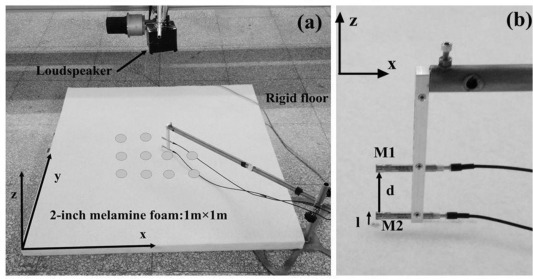The acoustic environment is an important aspect of room comfortableness, and installing sound absorbing materials is an effective means of reducing noise and improving the indoor acoustic environment. In designing noise control plans for building, two acoustic properties of sound absorbing material are normally required. They are absorption coefficient and acoustic impedance.
Researchers ZHANG Yankai, KUANG Zheng, WU Ming and YANG Jun from the Key Laboratory of Noise and Vibration Research of the Institute of Acoustics, Chinese Academy of Sciences recently propose a new method of measuring the acoustic impedance and absorption coefficient of sound absorbing material in situ.
It employs a single loudspeaker to synthesize a virtual array of loudspeakers which reproduce the plane wave sound field in front of the material surface. This method is based upon the sound field reconstruction technique and the transfer function method.
It demonstrates higher accuracy in measuring both acoustic impedance and absorption coefficient for the strongly-absorbing material sample in the frequency range of 175-1.6 k Hz, as well as for the weakly-absorbing material sample in the frequency range of 250-1.6 k Hz.
Actually, several methods have been available to measure the normal incidence absorption coefficient and the normal acoustic impedance of materials. In laboratory, the most commonly used methods are the standing wave method and transfer function method. Both methods can measure normal absorption coefficient and normal acoustic impedance, and are implemented in an impedance tube. However, they have limitations caused by the impedance tube.
To solve the problem, a parametric loudspeaker system has been used to generate plane wave sound field, and the results have shown good agreement with those measured in the impedance tube at medium and high frequencies.
However, the frequency limitation of parametric loudspeaker prevents accurate estimation of the absorption coefficients at frequencies below 500 Hz. Virtual planar loudspeaker array synthesized using a moving point sound source is also used to reproduce diffuse sound field for measuring random incidence absorption coefficient in free-field conditions.
In this research, plane wave sound field is reproduced by weighted summation of signals in response to one single loudspeaker to synthesize a virtual array of loudspeakers, and the reflection factor of the material is measured with the transfer function method.
Simulation result shows that in the frequency range of 100-1.6 k Hz, the absorption coefficient measured with this method is theoretically in good agreement with the real value.
Experiments are conducted in a semi-anechoic chamber to test the proposed method, with the setup shown in Fig. 1. The semi-anechoic chamber is located in the Institute of Acoustics of the Chinese Academy of Sciences, with dimensions of 15.6 m (depth) × 9.6 m (width) × 7.8 m (height) and cutoff frequency of around 80 Hz. The test sample is laid directly on the rigid floor.

Fig. 1. Experimental setup for measurement with the proposed method (Image by ZHANG).
It shows that compared with two other in-situ measurement methods (the spherical decoupling method and the iterative method), the proposed method is more accurate in measuring the acoustic impedance and the absorption coefficient of the strongly-absorbing material (2-inch-thick melamine foam) sample in the frequency range of 175-1.6 k Hz.
It also displays higher accuracy in measuring the absorption coefficient and acoustic impedance of the weakly-absorbing material sample in the frequency range of 250-1.6 k Hz.
Experimental results and theoretical analysis also show that insufficient signal-to-noise ratio and unwanted reflected waves contribute to the insufficient accuracy of this method below 175 Hz. Larger fluctuation in the measured absorption coefficient at high frequencies could be caused by inaccurate plane wave sound field reproduction with the least square method.
Reference:
ZHANG Yankai, KUANG Zheng, WU Ming, YANG Jun. In-situ Measurement of Sound Absorbing Properties Using Plane-wave Sound Field Reproduced by Virtual Loudspeaker Array. Building and Environment (Vol. 94, No.2, pp. 883-890, December 2015). DOI: 10.1016/j.buildenv.2015.07.003
Contact:
YANG Jun
Key Laboratory of Noise and Vibration Research, Institute of Acoustics, Chinese Academy of Sciences, 100190Beijing, China
Email: jyang@mail.ioa.ac.cn


